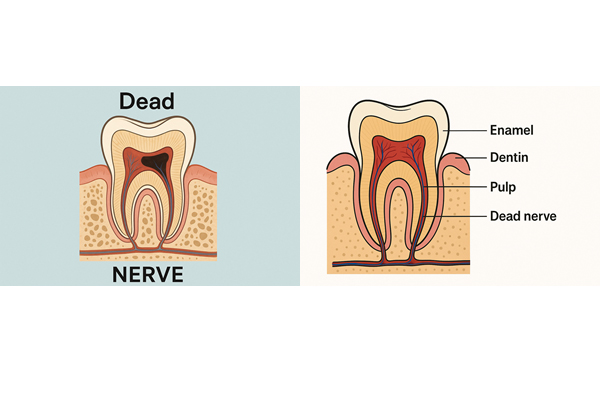Have you ever had a toothache that suddenly stopped hurting? You might think it must have been a miracle, but it could actually be a warning sign of something more serious. It could also mean that that tooth may have a dead nerve, also known as a non-vital or necrotic tooth.
While this can happen without much pain, a dead nerve in a tooth can lead to long-term dental issues if you leave it untreated.
But what causes a dead nerve in the tooth to happen? What could be the symptoms and signs for you to know it is already happening, and what treatment options are there to help?
What Is a Dead Nerve in a Tooth?
We all know our teeth are strong and sturdy, but they are not lifeless. Deep within their structure is a living core called the pulp, which contains nerves, blood vessels, and connective tissue. The pulp sits in a hollow space called the root canal and is essential for the tooth’s development and function, especially in sensing pain, pressure, and temperature.
When the pulp becomes damaged, either through trauma or infection, the blood supply to the nerve can be cut off. Once this happens, the nerve tissue dies, resulting in what we call a dead nerve in the tooth or a non-vital tooth.
Even though the hard outer parts of the tooth remain intact, a dead nerve can still happen. This just means that the tooth has lost its ability to feel sensations, and worse, it may become a breeding ground for bacteria.
Dead Nerve in Tooth Symptoms: What to Watch For
The symptoms of a dead tooth are not always obvious, but there are warning signs that you should not ignore. Here’s how to know if the nerve in your tooth is dead or dying:
1. Tooth Discolouration
One of the most visible signs is a change in the tooth’s colour. A dead or dying tooth may turn grey, yellow, brown or even black. This happens because the tissues inside the tooth start to break down and leak into the dentin layer. In addition, it’s not just a cosmetic issue because it often indicates a deeper problem.
2. Loss of Sensitivity
In the early stages, you may feel sensitivity to hot, cold, or sweet foods. But once the nerve is dead, the tooth may stop reacting altogether. If a once-sensitive tooth suddenly goes numb, that’s a red flag.
3. Pain (Or Pain That Goes Away Suddenly)
Before the nerve completely dies, the pulp may become inflamed or infected, which can cause sharp, throbbing, or lingering pain. Oddly enough, some people stop feeling pain once the nerve dies. But this does not mean the problem is gone. This just means the nerve is no longer alive to send pain signals.
4. Swelling, Pimple on the Gums, or Bad Taste
If bacteria infect the dead tissue inside the tooth, it can lead to an abscess, which is a painful collection of pus. You may notice swelling, a gum boil (pimple), a persistent bad taste, or even pus draining into your mouth. If this happens, it is a serious sign of infection that needs urgent attention.
What Happens If the Nerve in Your Tooth Is Dead?
Many people assume that once a tooth stops hurting, the problem has gone away. However, a dead nerve in your tooth can still lead to serious complications.
When a tooth is no longer alive, it becomes vulnerable to bacterial infection, which can spread from the root into the surrounding jawbone and soft tissues. This often leads to the formation of an abscess, a pocket of pus that can cause swelling, pain, and further infection. Over time, the bone that supports the tooth may begin to deteriorate, increasing the risk of tooth loss.
A dead tooth is also more fragile and prone to cracking or breaking. In rare but serious cases, bacteria from the infected tooth can enter the bloodstream, potentially affecting other parts of the body. That’s why it’s essential to seek dental care, even if you’re no longer feeling pain.
Treatment Options for a Dead Tooth
Once a tooth nerve has died, it will not recover on its own. However, you may able to consult with your dentist who can treat it with the following methods:
1. Root Canal Treatment
This is the most common and effective way to save a dead tooth. During a root canal, your dentist removes the dead nerve tissue, cleans the root canal, and seals it. After that, the tooth is usually restored with a crown for strength and protection. A properly treated tooth can last many years, even decades with proper maintenance.
2. Tooth Extraction
If the tooth is severely damaged or the infection has spread too far, it may need to be removed to prevent the formation of abscess in the area. After extraction, you can consider options like a dental implant, bridge, or partial denture to replace the missing tooth and restore your bite.
Don’t Wait Until It’s Too Late
A dead nerve in your tooth might not always hurt, but it can lead to serious consequences if ignored. Discolouration, loss of sensitivity and swelling are warning signs that something’s wrong.
If you’ve been wondering how to know if the nerve in your tooth is dead, the best thing you can do is visit your dentist for a proper check-up. Early diagnosis and treatment can help save the tooth and prevent painful infections.
Consult with our dentists at Bellevue Hill Dental to give you a better understanding of what’s happening below the surface. Book your consultation with us today.



